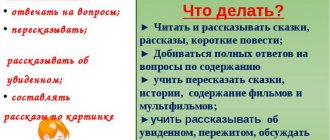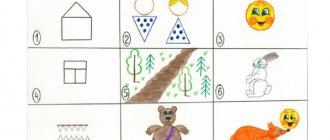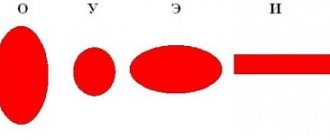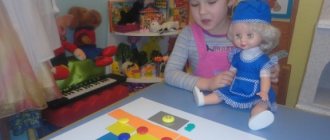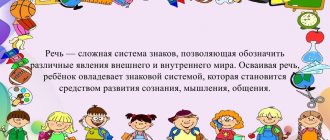The use of mnemonics in speech therapy sessions with children
Preschool age is considered the most favorable, since during this period of a child’s life the foundations of literacy, clear pronunciation of words, and beautiful speech are laid. These are very important conditions that influence the mental education of a child. A child with speech impairment has the following problems:
- Minimum set of words.
- Inability to form sentences from words.
- Impaired pronunciation of certain sounds.
- Disturbed attention.
- Broken logic.
When faced with such a problem, you can use mnemonics. Thanks to it you will achieve the following results:
- The child’s connected speech and associative thinking will improve.
- The child will be able to better assimilate the material using visual and auditory memory.
- The child’s imagination will work better and the process of memorizing sounds will speed up.
Mnemonic squares are an ideal method, a symbol of any successful lesson. Thanks to such schemes, you will quickly teach your child to learn poems, riddles, and tongue twisters.
Mnemonics in the classroom
The stages of study are:
- Read the poem expressively to your child.
- Ask your child to learn the verse with you.
- Read the poem again, focusing on the mnemonic table.
- Ask your child questions about the verse. Help him if necessary, clarify with him the main idea of the work.
- Find out from your child exactly which words seemed incomprehensible to him. Explain what they mean.
- Read each line of the verse separately. Ask your child to repeat the verse.
- At the very end, the child will have to recite a poem.
In the mnemonic table that you will use, enter all the characters in the verse. Thanks to this, your baby will learn to concentrate, construct sentences correctly and express his own speech.
Mnemonics for learning vocabulary words: techniques, word associations
To study vocabulary words, the following types of mnemonics are used:
- Visual associations.
- Sound associations.
- Mnemonics of “connections” and many others.
Children like visual associations the most. While memorizing a certain word, invite your child to look at a picture that will represent the word, plus he will be able to play with a letter that is difficult to remember. For example, draw the word “Magnet” and the letter “A” in the picture. When choosing other words, focus on those letters that your baby cannot say or write.
Also, in other words, depict the letters that cause difficulties for the child while writing with pictures, taking into account the meaning of the word itself. In the word “Kopeyka” the second letter is very similar to a penny. Therefore, draw her instead.
The next technique is sound associations. For example, the word “Breakfast” is similar to the word “Cancer”. By combining these words into one single phrase, you can get the sentence: “ There will be boiled crayfish breakfast .” Your child will learn this word using sound association. And the phrase itself sounds more melodic, therefore, it is remembered without problems.
Mnemonics in kindergarten based on fairy tales: methods for preschool teachers
You can train children’s memory and teach them to retell some texts on a variety of topics even in kindergartens. For this type of mnemonics, teachers, as a rule, use reference diagrams. Learning begins at the age of 1 or 2, when the child is already familiar with some fairy tales and tries to tell them, confusing characters and events. Special mnemonic tables for preschool children are compiled by teachers based on fairy tales known to them.
The images in the table cells are fairy tale characters. A fairy tale called “Kolobok” is quite convenient for such practice. In this table, events are repeated from time to time, and characters change. For children 2 years old, tables consisting of 4 – 9 cells, no more, are suitable.
The following tables are drawn by the teacher and the children. The children will take part in the compilation of such mnemonic tables with great pleasure. In the future, they will independently come up with tables for any fairy tale, complicating them a little, increasing the number of cells themselves.
Memory improvement in this case occurs due to the regular encoding of verbal information into pictures and vice versa. As a result, children scroll through the received material in their heads several times, memorizing it automatically.
For children over 5 years old the task becomes a little more complicated:
- Option 1. The table includes characters from completely different fairy tales. Then the children determine which characters in the table are superfluous.
- Option 2. Fairy tale characters are mixed in the table. Children must distribute these heroes into the correct tables.
- Option 3. The tables are cut, then the children restore them themselves. The cards are scattered, the teacher reads a fairy tale, and the children find the necessary image.
Mnemonics for children: tables of numbers, letters, symbols
The simplest method for allowing a child to remember numbers, letters and symbols is a table. You can draw such tables yourself using our tips.
In order to remember numbers, make diagrams by placing numbers and associations to them. Example:
| 1 | Stake, spear, pen, stick |
| 2 | Swan, duck, lantern |
| 4 | Chair, armchair |
| 7 | Hatchet |
To memorize letters, make a similar diagram, only the essence here is slightly different. Place the letters in the first column, and in the second, draw images whose names begin with this letter.
| A | Watermelon, Pineapple, Stork |
| IN | Wolf, Grapes |
| G | Pear, Mushroom |
| M | Raspberries |
| WITH | Sun, Dog |
Making mnemonic tables
The mnemonic table can be drawn by hand or made up of pictures, like a collage. At the initial stage of learning, it is better to draw small ribbon tables, placing 3-4 pictures in a row. Children are interested in coloring these pictures, and later they can give you their own ideas for drawing.
To create a mnemonic table, you need:
- Break the story into parts, identifying important points (every 2-3 words), draw a sheet of paper into squares;
- Draw a picture for each such moment (describing nouns or adjectives);
- If possible, depict unclear words (verbs or questions) somehow or simply put a “?” sign. The child will need to comment on this.
Various riddles or fairy tales are easier and more fun for young children if they are analyzed in situations and depicted in pictures. Then the child is asked to remember what was described and tell it step by step, looking at the pictures.
At the same time, the following processes occur in the child’s head:
- Looking at pictures and understanding what is shown in them;
- Recoding information from visual to figurative, comparing a picture with a concept;
- Compiling a story from pictures;
- Memorizing a story or poem.
A child in the senior group of kindergarten can independently draw pictures for a mnemonic table after the teacher has broken the story down into situations and told him what to draw. You can draw a mnemonic table for the seasons in a simple and interesting way. Here is a description of winter:
It is better to start working using mnemonic tables with children from the age of 4 years, when they have already developed an initial vocabulary. At this age, you can teach children rules based on tables. These can be algorithms for dressing or washing; there are also mnemonic tables for traffic rules so that the child quickly learns the rules of the road.
Children will enjoy learning fairy tales or poems using the tables:
Our Tanya is crying loudly, She dropped a ball into the river. Hush, Tanya, don't cry! The ball will not drown in the river.
As soon as the child understands the purpose of the mnemonic tables, you can increase the number of pictures, as well as the complexity of the task:
You can make puzzles, riddles or mnemonic tables in mathematics. In the latter case, it is enough to draw a number, and in another square a picture depicting this number. Subsequently, the child retains the corresponding picture in his memory when he sees a number.
If you cannot or do not have time to draw mnemonic tables, you can easily find them on the Internet and download them, then print them and practice with your child. It is better not to show it on a computer; the child will not perceive the screen in the same way as the piece of paper in front of him.

